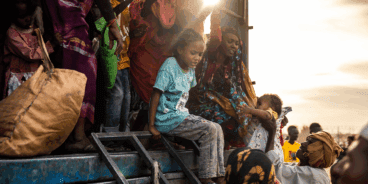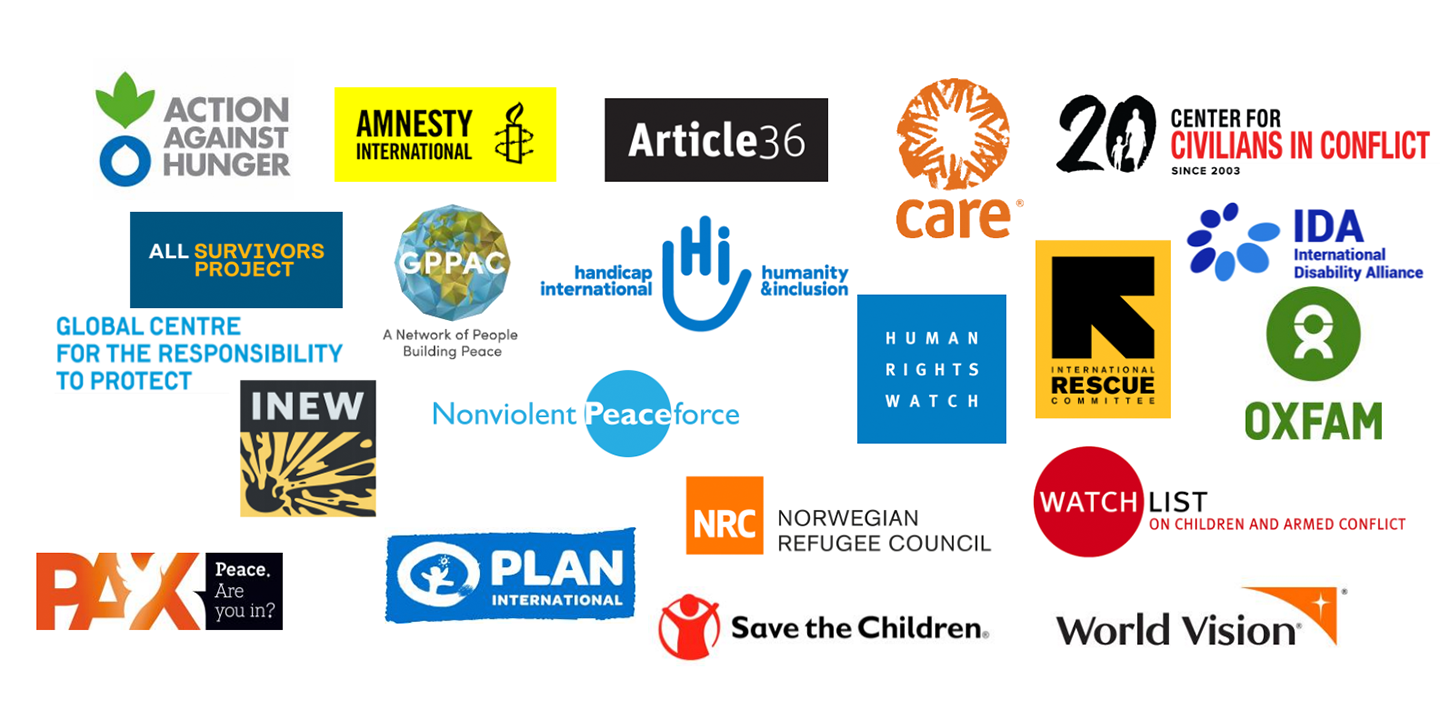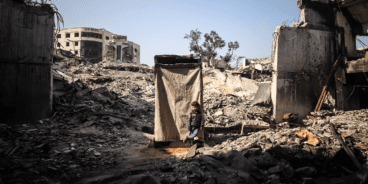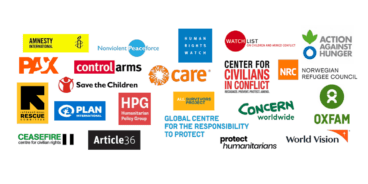

Statement by members of the NGO Working Group on the Protection of Civilians
Ahead of the UN Security Council’s annual Open Debate on the Protection of Civilians on 23 May 2023, the undersigned international NGOs urge UN Member States to address three critical issues: 1) recognize the wide-ranging and long-lasting impact of conflict and hunger on civilians, including the disproportionate impact on marginalized groups; 2) take measures to prevent civilian harm during conflict, implement UNSCR 2417, and ensure accountability for violations of international humanitarian law; and 3) address the climate-conflict-peace nexus. We set out recommendations that Member States can action immediately to save lives and invest in solutions that build food security, stability and peace.
Civilians are increasingly shouldering the burden of conflicts around the world. Today, 2 billion people – a quarter of humanity – live in places affected by conflict, as conflicts themselves are not only more numerous, but increasing in duration, lethality, and size. Civilians are facing extreme levels of humanitarian need, displacement, and food insecurity, with a disproportionate impact on women and girls, people with disabilities, older people, and other potentially marginalised groups.
This year’s Secretary-General’s Protection of Civilians (POC) report and the Security Council’s Open Debate brings a strong focus on conflict and hunger. Five years after UN Security Council resolution 2417, in which the Council unanimously recognized that conflict-induced food insecurity and the unlawful denial of humanitarian access threaten international peace and security, civilians find themselves in the midst of the most severe global hunger and malnutrition crisis in modern history. An expected 345.2 million people are projected to be food insecure this year – more than double the number in 2020.
Conflict is the main driver of hunger in many of the world’s most severe food crises. The deliberate destruction of food, livelihoods and civilian infrastructure has become a widespread tactic in conflicts where land and productive assets are deliberately targeted. At the same time humanitarian assistance is withheld, with physical and bureaucratic impediments used to restrict civilians’ access to food and to force them to flee their homes and communities.
Despite protections afforded to civilians in conflict under international humanitarian law (IHL), international human rights law (IHRL), UNSCR 2417, as well as UNSCR 2573 – which, in 2021, condemned attacks against objects indispensable to the survival of the civilian population – violations of IHL and IHRL continue to have far-reaching effects on conflict-induced food insecurity and, all too often, they take place with near impunity. Starvation has been used as a method of warfare in active conflicts today.
Fighting in cities and towns involves the use of increasingly powerful explosive weapons with wide area effects. Between 2011-2020, on average civilians constituted 90% of those killed and wounded from attacks carried out with explosive weapons in populated areas. Nearly half of all verified child casualties in conflict are from explosive weapons and the remnants of war. Beyond the direct harm to civilians, damage to critical civilian infrastructure impacts food production and availability, access to safe water and sanitation, electricity, and other essential services. This has long-lasting impacts on civilians’ health, nutrition, safety, and wellbeing, with consequences that can last for decades after a war has ended.
Even indirectly, conflict on one side of the world can have far reaching impacts on civilians in other regions, fuelling global economic crises, eroding local support systems, and inflating food prices, as evidenced by recent conflicts. This further weakens communities’ resilience, ability to access and purchase food, and contributes to the erosion of decades of hard-won development gains. The ripple effects of conflicts, combined with climate variability, drought, and skyrocketing cost of living make the situation even worse for women and girls, who play a crucial role across food and water systems and in feeding their families and communities. Households have less access to positive coping mechanisms, which elevates the risk of children being forced to drop out of school, gender- based violence, women and girls being coerced into exchanging sex for food, and forced marriage including child marriage. Entrenched gender inequalities and gender norms surrounding food consumption disproportionately increase the vulnerability of women and girls to hunger and malnutrition and contributed to an estimated 150 million more women than men going hungry in 2021. In addition, persons with disabilities, in particular women and children, face additional barriers accessing food during armed conflict.
The climate crisis and conflict-related environmental degradation have compounded the detrimental impacts of food insecurity for civilians in conflict through a mutually reinforcing cycle. Climate change increases the scale and complexity of existing protection challenges and vulnerabilities, in particular in situations where civilians are already facing resource scarcity and conflict-related insecurity. Conflict also exacerbates environmental degradation by damaging and endangering ecosystems and critical environmental infrastructure including the destruction of agricultural fields and the pollution of soil and water systems. These effects pose potentially lethal and long-lasting risks to civilian lives and livelihoods. Meanwhile, conflicts also contribute to the weakening and breakdown of governance systems, as well as mitigation, and resilience capacities, creating conditions in which communities have fewer safety nets to counter the impacts of climate risks and environmental harm.
Protecting civilians has too often been understood only through the prism of compliance with IHL, but this is the bare minimum. Current patterns of harm and long-term effects of hostilities including on hunger and the environment highlight the need for policies and practices that effectively address the full protection of civilians in all their diversity.
We therefore make these recommendations to all UN Member States
Preventing civilian harm in conflict, strengthening implementation of UNSCR 2417 and promoting accountability:
-
-
- Parties to a conflict should take action to protect civilians and their livelihoods from the multidimensional impacts of conflict, including by upholding IHL and IHRL and facilitating unhindered humanitarian access; preventing attacks on civilian infrastructure which is critical to the delivery of humanitarian aid; safeguarding the functioning of food systems and markets in conflict as set out in UNSC Resolution 2417. Member States should design and implement national POC policies as well as relevant on-the-ground operational procedures and practices to mitigate civilian harm, including for security partners and allies, ensuring investigation and accountability for violations, and providing amends for victims and In so doing, States should actively and meaningfully consult with civil society.
- The UNSC should more effectively utilize the early warning and prevention functions of UNSC Resolution 2417 and request regular briefings on contexts where conflict is a leading driver of hunger and famine. At a minimum, the UNSC should receive two White Notes per year setting out where there is a risk of famine driven by conflict and widespread food insecurity in the context of armed This should include the collection, analysis and use of sex-, age-, disability, and diversity-disaggregated food security data.
- Member States should encourage and support the Secretariat and UN peace operations to increase integration and cooperation in analyzing, preventing, and addressing the impact of conflict on food insecurity, as mandates and capacities Missions need improved capabilities, expertise, and resources to assess and mitigate environmental and climate risks, including through supporting training to better mainstream environmental expertise in mission settings.
- Member States who have not yet done so should endorse the ‘Political Declaration on Strengthening the Protection of Civilians from the Humanitarian Consequences arising from the Use of Explosive Weapons in Populated Areas’. Signatory States should move quickly to turn their commitments into action by restricting or refraining from the use of explosive weapons in populated areas.
- Member States should resource and commit to strengthening international and domestic accountability mechanisms for violations of IHL, including starvation crimes, attacks against healthcare, aid workers, schools and other objects indispensable to the survival of the civilian population. This could include direct bilateral actions, for example the use of Universal Jurisdiction, or action at the global level such as the establishment of independent fact-finding missions. Such bodies should include specific expertise to ensure that age, gender, disability or other specific characteristics are taken into consideration.
-
Addressing the climate-conflict-peace nexus:
-
-
- Member States and UN actors should engage, support, and coordinate with local peacebuilders in all efforts to sustain peace. This includes ensuring the safety and security of peacebuilders, activists, and human rights defenders, preventing reprisals and securing protections, addressing issues related to shrinking civic space and supporting unarmed approaches to civilian protection.
- The Security Council and the Peacebuilding Commission – as well as the UN’s own peace and security and peacebuilding architecture – should develop stronger synergies on climate and environmental issues, accounting for the more comprehensive and interlinking nature of climate and environmental risks in conflict-affected areas, including the environment as an essential component of sustainable peacebuilding programs. The experience and expertise of organizations working in conflict settings, particularly local NGOs, women-led and community-based organizations should be utilized and resourced. Actors closest to people in need are best able to access the most marginalised groups, engage with local communities and deliver conflict sensitive, inclusive, and gender-transformative multi-sectoral climate action.
-
Signed by,
- Action Against Hunger
- Amnesty International
- All Survivors Project
- Article 36
- CARE
- Center for Civilians in Conflict
- Global Centre for the Responsibility to Protect
- GPPAC
- Humanity and Inclusion
- Human Rights Watch
- INEW
- International Rescue Committee
- International Disability Alliance
- Nonviolent Peace Force
- Norwegian Refugee Council
- Oxfam
- PAX
- Plan International
- Save the Children
- Watchlist for Children and Armed Conflict
- World Vision
Related Content


Atrocity Alert No. 440: Israel and the Occupied Palestinian Territory, Protection of Civilians and Libya
